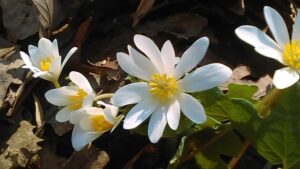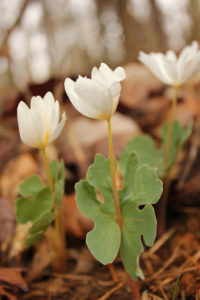By Wren Smith
 Easter weekend was indeed a celebration of new life on the Bent Twig Trail and elsewhere. Wildflower enthusiasts, naturalists, and hikers were rewarded by the bright presence of clusters of moon white bloodroot blossoms shining up from the forest floor. Bloodroot, Sanguinaria canadensis, has long been a favorite of mine, partially because it’s an early bloomer, and thus a sign of spring; but also because of its intriguing adaptations and ecological partnerships that contribute to its survival. Such relationships add another form of beauty, one that is tied to mystery. The flower grows from a thick orange red rhizome (root or underground stem) that puts forth a single multi-lobed leaf.
Easter weekend was indeed a celebration of new life on the Bent Twig Trail and elsewhere. Wildflower enthusiasts, naturalists, and hikers were rewarded by the bright presence of clusters of moon white bloodroot blossoms shining up from the forest floor. Bloodroot, Sanguinaria canadensis, has long been a favorite of mine, partially because it’s an early bloomer, and thus a sign of spring; but also because of its intriguing adaptations and ecological partnerships that contribute to its survival. Such relationships add another form of beauty, one that is tied to mystery. The flower grows from a thick orange red rhizome (root or underground stem) that puts forth a single multi-lobed leaf.
This leaf is curled protectively around a white bud, guarding it from the cold winds of early spring. When the petals of the young bud have grown in substance and the days warm, the flower unfurls with a frantic burst of activity more fitting of a housewife preparing for a visit by the queen. In this case, it’s the visiting pollinators that focus the energy and instructions buried in the bloodroot’s ancient DNA. With luck, the bees and other insects will provide the needed services; and before spring is over, the seeds will form and fall to the ground. And here is where another ecological partnership comes in to play: bloodroot seeds have a fleshy attachment called an alaiosome, that ants find irresistible. Through the dance of evolution, ants and bloodroot along with some other plants, have developed a process know by scientists as myrmecochory. In myrmecochory ants are attracted to the apparently tasty tidbits attached to these seeds and cart them off to their underground nests. Here the ants feast on the alaisome, but guard the seeds, surrounding them in the fertile soil of the ant nest and ant droppings. This increases the likelihood of successful propagation. Such lovely orchestrated dances are a part of the mystery and beauty in co evolution happening all around us.
I will write more about bloodroot in next week’s post, but you should get out to see them before the flowers are gone.
Want more Tales from Bent Twig? Click here to view the archive.


